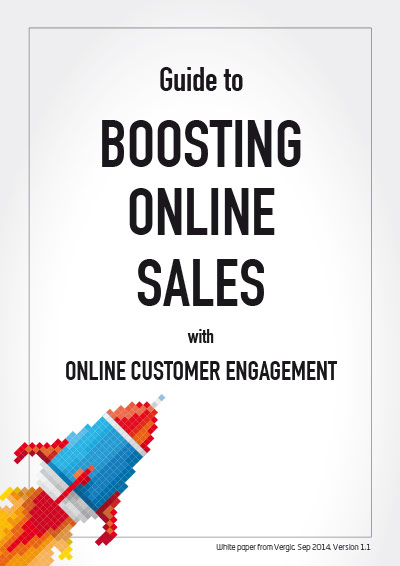Step 3: Factors to focus on before, during and after implementation
 Online customer engagement is not your typical plug-and-play tool for the simple reason of what it is used for. When operating at its best, online customer engagement helps people enjoy more personal, engaging and efficient online experiences. This is driven by personal, real-time, collaborative, useful connectivity between e-commerce site employees and customers. The technology acts as an interface for sites to share information, resolve issues and collaborate with customers — online and in real-time.
Online customer engagement is not your typical plug-and-play tool for the simple reason of what it is used for. When operating at its best, online customer engagement helps people enjoy more personal, engaging and efficient online experiences. This is driven by personal, real-time, collaborative, useful connectivity between e-commerce site employees and customers. The technology acts as an interface for sites to share information, resolve issues and collaborate with customers — online and in real-time.
Factors to focus on before, during and after implementation include:
- Make it easy for customers to engage with real agents (or feel personally assisted)
- Help agents provide personal and accurate shopping experiences
- Increase the number of agent-assisted dialogs
- Reinforce your desired brand culture and image
The following is intended to provide an overview of each factor:
Step 3a – Make it easy for customers to engage with real agents (or feel personally assisted)
Ensuring customers enjoy a positive shopping experience at your webshop is the single most important factor in online sales conversion. And it is dependant upon providing personal service. So the greater amount of personal service you offer your online customer, the greater the potential for sales conversion.
Allowing your customers to directly interact with webshop employees always makes sense. This is evidenced by the exponential rise in consumer preference for using live chat. However, even simple automated online customer engagement functions — like dynamically adding layers of text or visuals to help customers gather facts or evaluate features, pricing and cost calculation — delights customers as they feel the marketer respects their time.
What is of high interest and relevancy? To which shopper? At which phase of the purchasing decision is a customer operating in now? Answer these fundamental sales questions to make it easy for customers to engage with real agents (or feel personally assisted). With these insights you can determine whether your site should offer reactive, proactive or both activation options for online customer engagement. Reactive mode requires the user to click a button on the site to launch chat or another function; proactive mode directly alters the online experience — for example, via a pop-up window or lightbox and dialog script — to invite the visitor to engage with an agent.
Coverage is another aspect to consider: should you permit online customer engagement on all high priority sales pages? Every page? Only on site navigation or similar areas? Again: the easier it is for customer to enjoy the feeling of personal service during their shopping experience, the greater the potential for sales.

Step 3b – Help agents provide personal and accurate shopping experiences
Online customer engagement technology is simply a tool. It does not execute the sales conversion alone — the person using the online customer engagement tool accounts for 40% of the success.
Online customer engagement driven e-commerce takes into account the real behavior of each visitor in real-time. As such, it offers typical conversion process maps based on identified, real opportunities — like sales cheat sheets — for your agents. Agents then use the solution modules to guide and quickly respond to actions and preferences of consumers — all in real-time, while evaluations and decisions happen. Customer engagement is ultimately generated by your employees — sales and customer service agents. Personal sales and service fosters trust. Research clearly shows that consumers are much more likely to trust agents than automated marketing only, especially when shopping online.

Agent skills and confidence are key to their ability in providing the type personal and accurate shopping experiences that lead to sales. High agent turnover and slow start-up results are common issues that can negatively affect results. At the same time, individual agents are just that: individuals. When agents feel empowered to make a difference, they take more pride in their work, are more effective and inspired to accomplish more and act in a more responsible manner.
Providing good service during the shopping experience is about timeliness, the accuracy and the quality of the information that is provided as well as personal advice, tips and inspiration. So the goal should always be for all agents to offer consistent support levels: any issue, solved by any agent, at any time. Online customer engagement technology helps improve agent efficiency, profitability and satisfaction. Be sure to empower your agents with proper training and by seamlessly integrating information so they can help customers with the greatest of efficiency.
Step 3c – Increase the number of agent-assisted dialogs
When setting call center performance metrics for online customer engagement technology, it is important to remember that agents are not only working with issue resolution — agents help drive and secure revenue. If it is to be a sales-focused contact center, the metrics should incorporate those for revenue generation as well as handle times.
Consumer expectations for more personal, human online shopping experiences continue to grow. While chat has come a long way in recent years, it serves as an example of the evolution that is now taking place. Text-based chat techniques focus on agents being able to “avoid robot responses” by promoting natural conversation style. This calls for a careful balance of both scripted and spontaneous tactics. But it’s time to go beyond text and incorporate visual and speech. Visual and speech chat are significantly improving web self-service and are a natural sales support tools.
The most important factor is increasing the total number of dialogs an agent handles. An agent with a 10% conversion rate that interacts in 10 chats secures one order. By doubling that agent’s number of interactions, you double his contribution to sales. More agent-assisted dialogs secure more revenue.

Step 3d – Reinforce your desired brand culture and image
When setting call center performance metrics for online customer engagement technology, it is important to remember that agents are not only working with issue resolution — agents help drive and secure revenue. If it is to be a sales-focused contact center, the metrics should incorporate those for revenue generation as well as handle times.
Consumer expectations for more personal, human online shopping experiences continue to grow. While chat has come a long way in recent years, it serves as an example of the evolution that is now taking place. Text-based chat techniques focus on agents being able to “avoid robot responses” by promoting natural conversation style. This calls for a careful balance of both scripted and spontaneous tactics. But it’s time to go beyond text and incorporate visual and speech. Visual and speech chat are significantly improving web self-service and are a natural sales support tools.
The most important factor is increasing the total number of dialogs an agent handles. An agent with a 10% conversion rate that interacts in 10 chats secures one order. By doubling that agent’s number of interactions, you double his contribution to sales. More agent-assisted dialogs secure more revenue.












